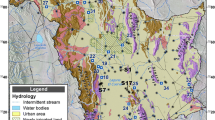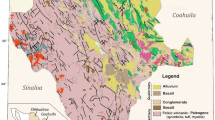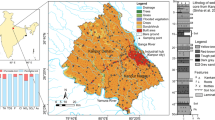Abstract
Arsenic (As) and fluoride (F−) in groundwater are increasing global water quality and public health concerns. The present study provides a deeper understanding of the impact of seasonal change on the co-occurrence of As and F−, as both contaminants vary with climatic patterns. Groundwater samples were collected in pre- and post-monsoon seasons (n = 40 in each season) from the Brahmaputra flood plains (BFP) in northeast India to study the effect of season on As and F− levels. Weathering is a key hydrogeochemical process in the BFP and both silicate and carbonate weathering are enhanced in the post-monsoon season. The increase in carbonate weathering is linked to an elevation in pH during the post-monsoon season. A Piper diagram revealed that bicarbonate-type water, with Na+, K+, Ca2+, and Mg2+ cations, is common in both seasons. Correlation between Cl− and NO3 − (r = 0.74, p = 0.01) in the post-monsoon indicates mobilization of anthropogenic deposits during the rainy season. As was within the 10 µg L−1 WHO limit for drinking water and F− was under the 1.5 mg L−1 limit. A negative correlation between oxidation reduction potential and groundwater As in both seasons (r = −0.26 and −0.49, respectively, for pre-monsoon and post-monsoon, p = 0.05) indicates enhanced As levels due to prevailing reducing conditions. Reductive hydrolysis of Fe (hydr)oxides appears to be the predominant process of As release, consistent with a positive correlation between As and Fe in both seasons (r = 0.75 and 0.73 for pre- and post-monsoon seasons, respectively, at p = 0.01). Principal component analysis and hierarchical cluster analysis revealed grouping of Fe and As in both seasons. F− and sulfate were also clustered during the pre-monsoon season, which could be due to their similar interactions with Fe (hydr)oxides. Higher As levels in the post-monsoon appears driven by the influx of water into the aquifer, which drives out oxygen and creates a more reducing condition suitable for reductive dissolution of Fe (hydr)oxides. An increase in pH promotes desorption of As oxyanions AsO4 3− (arsenate) and AsO3 3− (arsenite) from Fe (hydr)oxide surfaces. Fluoride appears mainly released from F−-bearing minerals, but Fe (hydr)oxides can be a secondary source of F−, as suggested by the positive correlation between As and F− in the pre-monsoon season.









Similar content being viewed by others
References
Ahmed KM, Bhattacharya P, Hasan MA, Akhter SH, Alam SM, Bhuyian MH, Imam MB, Khan AA, Sracek O (2004) Arsenic enrichment in groundwater of the alluvial aquifers in Bangladesh: an overview. Appl Geochem 19:181–200
APHA (2005) Standard methods for the examination of water and wastewater, 19th edn. American Public Health Association, Washington
Arveti N, Sarma MR, Aitkenhead-Peterson JA, Sunil K (2011) Fluoride incidence in groundwater: a case study from Talupula, Andhra Pradesh, India. Environ Monit Assess 172:427–443
Balasundaram MS (1977) Contribution to geomorphology and geohydrology of the Brahmaputra valley. Geol Surv India
Bhattacharya P, Frisbie SH, Smith E, Naidu R, Jacks G, Sarkar B (2002) Arsenic in the environment: a global perspective. Handbook of heavy metals in the environment. Marcell Dekker Inc., New York, pp 147–215
Bhattacharya R, Jana J, Nath B, Sahu SJ, Chatterjee D, Jacks G (2003) Groundwater As mobilization in the Bengal Delta Plain, the use of ferralite as a possible remedial measure a case study. Appl Geochem 18:1435–1451
Bhuyan B, Bhuyan D (2011) Groundwater arsenic contamination status in Dhakuakhana sub-division of Lakhimpur district, Assam, India. ActachimicapharmaIndica 1:14–19
Brindha K, Rajesh R, Murugan R, Elango L (2011) Fluoride contamination in groundwater in parts of Nalgonda district, Andhra Pradesh, India. Environ Monit Assess 172:481–492
Brunt R, Vasak L, Griffioen J (2004) Fluoride in groundwater: probability of occurrence of excessive concentration on global scale. IGRAC
Bundschuh J, Farias B, Martin R, Storniolo A, Bhattacharya P, Cortes J, Bonorino G, Albouy R (2004) Groundwater arsenic in the Chaco-Pampean plain, Argentina: case study from Robles county, Santiago del Estero province. Appl Geochem 19:231–243
Chakraborti D, Chanda CR, Samanta G, Chowdhury UK, Mukherjee SC, Pal AB, Sharma B, Mahanta KJ, Ahmed HA, Sing B (2000) Fluorosis in Assam, India. Curr Sci 78:1421–1423
Chen K, Jiao JJ, Huang J, Huang R (2007) Multivariate statistical evaluation of trace elements in groundwater in a coastal area in Shenzhen, China. Environ Pollut 147:771–780
Critto A, Carlon C, Marcomini A (2003) Characterization of contaminated soil and groundwater surrounding an illegal landfill (S. Giuliano, Venice, Italy) by principal component analysis and kriging. Environ Pollut 122:235–244
Das BK, Kaur P (2001) Major ion chemistry of Renuka lake and weathering processes, Sirmaur district, Himachal Pradesh, India. Environ Geol 40:908–917
Das B, Talukdar J, Sarma S, Gohain B, Dutta RK, Das HB, Das SC (2003) Fluoride and other inorganic constituents in groundwater of Guwahati, Assam, India. Curr Sci Bangalore 85:657–660
Evans P (1964) The tectonic framework of Assam. J GeolSoc India 5:80–96
Fisher RS, Mullican WF III (1997) Hydrochemical evolution of sodium-sulfate and sodium-chloride groundwater beneath the northern Chihuahuan Desert, Trans-Pecos, Texas, USA. Hydrogeol J 5:4–16
Ghosh NC, Singh RD (2009) Groundwater Arsenic Contamination in India: vulnerability and Scope for Remedy. NIH, Roorkee
Gibbs RJ (1970) Mechanisms controlling world water chemistry. Science 170:1088–1090
Halim MA, Majumder RK, Nessa SA, Hiroshiro Y, Sasaki K, Saha BB, Saepuloh A, Jinno K (2010) Evaluation of processes controlling the geochemical constituents in deep groundwater in Bangladesh: spatial variability on arsenic and boron enrichment. J Hazard Mater 180:50–62
Harvey CF, Swartz CH, Badruzzaman AB, Keon-Blute N, Yu W, Ali MA, Jay J, Beckie R, Niedan V, Brabander D, Oates PM (2005) Groundwater arsenic contamination on the Ganges Delta: biogeochemistry, hydrology, human perturbations, and human suffering on a large scale. ComptesRendus. Geoscience 337:285–296
Heroy DC, Kuehl SA, Goodbred SL (2003) Mineralogy of the Ganges and Brahmaputra Rivers: implications for river switching and late quaternary climate change. Sed Geol 155:343–359
Huizing HG (1971) A reconnaissance study of the mineralogy of sand fractions from East Pakistan sediments and soils. Geoderma 6:109–133
Jain KS, Agarwal PK, Singh VP (2007) Hydrology and water resources of India. Water SciTechnol Library Springer 57:419–472
Kim SH, Kim K, Ko KS, Kim Y, Lee KS (2012) Co-contamination of arsenic and fluoride in the groundwater of unconsolidated aquifers under reducing environments. Chemosphere 87:851–856
Kumar M, Ramanathan AL, Rao MS, Kumar B (2006) Identification and evaluation of hydrogeochemical processes in the groundwater environment of Delhi, India. Environ Geol 50:1025–1039
Kumar M, Kumari K, Singh UK, Ramanathan AL (2008) Hydrogeochemical processes in the groundwater environment of Muktsar, Punjab: conventional graphical and multivariate statistical approach. Environ Geol 57:873–884
Kumar M, Kumar P, Ramanathan AL, Bhattacharya P, Thunvik R, Singh UK, Tsujimura M, Sracek O (2010a) Arsenic enrichment in groundwater in the middle Gangetic Plain of Ghazipur District in Uttar Pradesh, India. J Geochem Explor 105:83–94
Kumar P, Kumar M, Ramanathan AL, Tsujimura M (2010b) Tracing the factors responsible for arsenic enrichment in groundwater of the middle Gangetic Plain, India: a source identification perspective. Environ Geochem Health 32:129–146
Liao CM, Lin TL, Chen SC (2008) A Weibull-PBPK model for assessing risk of arsenic-induced skin lesions in children. Sci Total Environ 392:203–217
Mahanta C (1995) Distribution of nutrients and toxic metals in the Brahmaputra River Basin. Ph.D thesis Jawaharlal Nehru University, India
Mithal RS, Srivastava LS (1959) Geotectonic positions and earthquakes of Ganga-Brahmaputra region. In: Proceedings of the first symposium on earthquake engineering. University of Roorkee, Roorkee, India
Mukherjee A, Sengupta MK, Hossain MA, Ahamed S, Das B, Nayak B, Lodh D, Rahman MM, Chakraborti D (2006) Arsenic contamination in groundwater: a global perspective with emphasis on the Asian scenario. J Health Popul Nutr 24:142–163
Pillai KS, Stanley VA (2002) Implications of fluoride an endless uncertainty. J Environ Biol Acad Environ Biol India 23:81–87
Piper AM (1953) A graphic procedure for the geo-chemical interpretation of water analysis. USGS groundwater. Note 12
Rajmohan N, Elango L (2004) Identification and evolution of hydrogeochemical processes in theground water environment in an area of the Palar and Cheyyar River Basins, Southern India. Environ Geol 46:47–61
Reddy DP (2012) Arsenic and iron contamination in ground water in lower Brahmaputra Basin in Bongaigaon and part of Dhubri Districts of Assam State. India Water Week-Water, Energy and Food Security, India
Reddy AG, Reddy DV, Rao PN, Prasad KM (2010) Hydrogeochemical characterization of fluoride rich groundwater of Wailpalli watershed, Nalgonda District, Andhra Pradesh, India. Environ Monit Assess 171:561–577
Saxena V, Ahmed S (2001) Dissolution of fluoride in groundwater: a water–rock interaction study. Environ Geol 40:1084–1087
Saxena V, Ahmed S (2003) Inferring the chemical parameters for the dissolution of fluoride in groundwater. Environ Geol 43:731–736
Singh AK (2004) Arsenic contamination in groundwater of North Eastern India. In: 11th national symposium on hydrology with focal theme on water quality. National Institute of Hydrology Roorkee, proceeding, Vol 255262
Smedley PL, Kinniburgh DG (2002) A review of the source, behaviour and distribution of arsenic in natural waters. Appl Geochem 17:517–568
Smedley PL, Nicolli HB, Macdonald DM, Barros AJ, Tullio JO (2002) Hydrogeochemistry of arsenic and other inorganic constituents in groundwaters from La Pampa, Argentina. Appl Geochem 17:259–284
Smedley PL, Zhang M, Zhang G, Luo Z (2003) Mobilisation of arsenic and other trace elements in fluviolacustrine aquifers of the Huhhot Basin, Inner Mongolia. Appl Geochem 18:1453–1477
Susheela AK (2001) Fluorosis: Indian scienario: a treatise on fluorosis. Fluorosis Research and Rural Development Foundation, Delhi
Tapponier P, Molnar P (1977) Active faulting and Cenozoic tectonics of China. J Geophys Res 82:2905–2930
Vencelides Z, Sracek O, Prommer H (2007) Modelling of iron cycling and its impact on the electron balance at a petroleum hydrocarbon contaminated site in Hnevice, Czech Republic. J Contam Hydrol 89:270–294
World Health Organization (WHO) (2008) Guidelines for drinking-water quality: incorporating first and second addenda to 3rd edn, vol 1, Recommendations
Acknowledgements
This work is funded by Science and Engineering Research Board (SERB), the Department of Science and Technology (DST), under the Govt. of India under the Fast Track Young Scientist Scheme awarded to Dr. Manish Kumar (SR/TP/ES-32/2012). Nilotpal Das likes to thank the assistance received from Council for Scientific and Industrial Research (CSIR)—India, for financial assistance as JRF [09/796(0052)/2012-EMR-1]. We acknowledge the help received for the cation analysis by IC, to the project “Physico-chemical characterization of aerosol and source apportionment in the mid-Brahmaputra plain in Assam: A modeling approach” funded by the Ministry of Earth Sciences, India: MoES/16/16/10-RDEAS.
Author information
Authors and Affiliations
Corresponding author
Electronic supplementary material
Below is the link to the electronic supplementary material.
Rights and permissions
About this article
Cite this article
Das, N., Sarma, K.P., Patel, A.K. et al. Seasonal disparity in the co-occurrence of arsenic and fluoride in the aquifers of the Brahmaputra flood plains, Northeast India. Environ Earth Sci 76, 183 (2017). https://doi.org/10.1007/s12665-017-6488-x
Received:
Accepted:
Published:
DOI: https://doi.org/10.1007/s12665-017-6488-x




